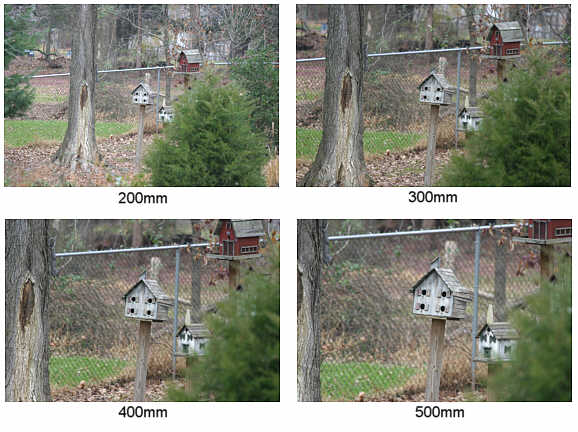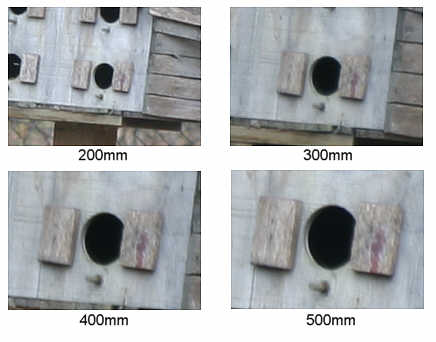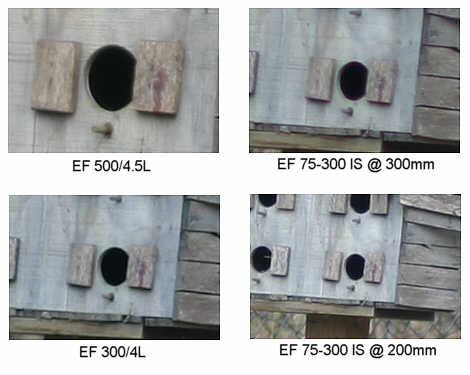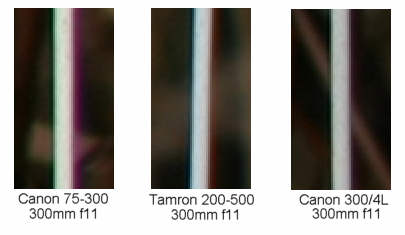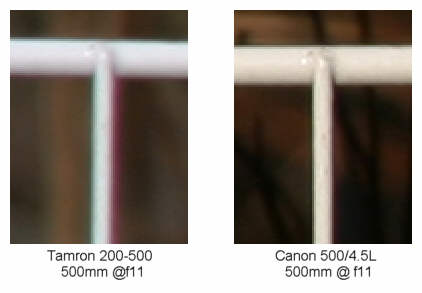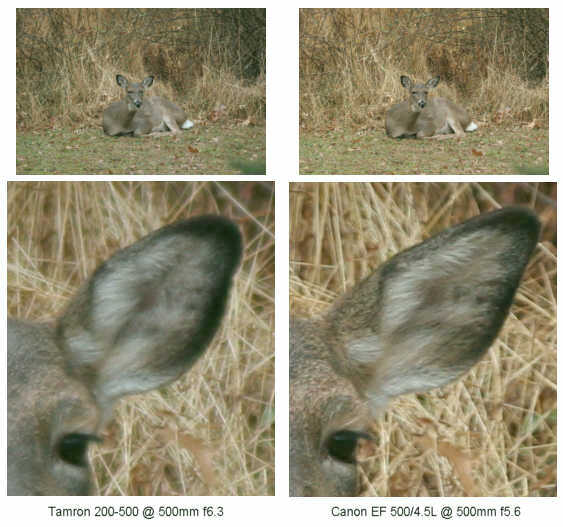
Tamron SP AF200-500MM F/5-6.3 Di LD (IF) |
Tamron SP AF200-500MM F/5-6.3 Di LD (IF) ReviewPart II - Optical PerformanceHere comes the part you've been waiting for! Just how good is this lens? Well, I performed a variety of tests, shooting both "regular" images and comparing them to other lenses (Canon EF 75-300/4-5.6 IS USM, Canon EF 300/4L USM and Canon EF 500/4.5L ISM), as well as shooting images of test targets and doing scientific (or at least semi-scientific) quantitative analysis of the results. I should mention here that I've been evaluating a lens/camera/printer testing software suite called Imatest, written by Norman Koren I'm not going to present hard data from Imatest in this review since I haven't used it enough to fully evaluate it and learn how to interpret the results, but at some point in the near future I hope to write a review of Imatest and use it to do some quantitative testing. It looks like a very interesting program. All testing was done using an EOS 10D DSLR with an APS-C sized sensor (approx 15.1 x 22.7mm). Tests for vignetting showed none at any focal length or aperture. Illumination was very uniform across the frame. Of course this would be expected since the lens is designed with full frame 35mm coverage and was tested on a camera with an APS-C sensor which crops the center 15x22mm region from the 43mm image circle. Vignetting on a full frame camera was not tested. It's not unusual to see some degree of vignetting in the corners of a full 35mm frame with any lens when used wide open.
The above sequence shows the effect of zooming from 200mm to 500mm. Of course you can't really tell much about image quality from such small images, so the following sequence of images show 100% crops from the center of each image.
Here are some comparison images shot with Canon lenses as indicated.
You'll probably see that there's not a whole lot of difference between any of the lenses! This is due to several factors. First the subject is low contrast and doesn't have a lot of fine detail. Second the images are all shot with an EOS 10D, which has a resolution limit of 65 lp/mm. Third all these crops are from the very center of the image, where aberrations in all lenses are at a minimum. There are differences, but they are small in this particular image sequence. So does that mean that the Tamron 200-500 is just as good as a Canon EF 300/4L or Canon EF500/4.5L? Well, not really as you can see from the following images. These are shots of a white bar against a dark background at the edge of an image. First a sequence shot at 300mm and f11. Note that chromatic aberration isn't a function of aperture, so the color fringing will be essentially the same wide open and stopped down. These are 200% enlargements of a crop from the test images.
As you can see, the Tamron 200-500 at 300mm falls somewhere between the Canon EF 75-300 IS and the Canon EF 300/4L. The use of LD (low dispersion) elements in the lens is clearly suppressing some of the chromatic aberration, though not quite as effectively as the UD elements of the Canon prime. Below are the results at 500mm. These are also 200% enlargements of a crop from the test images.
Obviously the Tamron 200-500 at 500mm is showing edge chromatic aberration. The Canon EF 500/4.5L is extremely clean with no visisble color fringing at all. Obviously the use of fluorite and UD elements in this lens is highly effective at eliminating chromatic aberration. However the Canon lens costs around $5000, so you pay dearly for the improvement. Comparing an $875 lens with a $5000 is, of course, not really fair, however a good reason to do this comparison with the much more expensive lens is to show that chromatic aberration is not being caused by the digital sensor in the camera. It has been suggested in some publications that color fringing can be caused by sensor aberrations. Whether or not this is ever true, it appears not the case in these tests. Here's a shot of a high contrast test target with lots of fine detail. All the images were shot at 500mm and f6.3, this time taking crops from the center of the image and a point 40% of the distance to the edge.:
This time, even in the center of the image, the Tamron 200-500 shows lower contrast (lower MTF) than the Canon lens (again though, remember you're paying around $5000 for the Canon lens!). Note however that the resolution in the top images (taken from the center of the frame) is very similar. Both are probably limited by the resolution of the sensor in the 10D. At 40% of the distance from the center, the Tamron lens has lost some sharpness and is starting to show some chromatic aberration. This is probably less of a problem in telephoto lens than in a wideangle lens, since telephoto lenses are usually used with the subject in the central region of the frame and limited DOF tends to render the background out of focus. Here's another image set shot at 500mm. The upper image is the full frame shot and the lower image is a 100% crop. Again, comparision with a $5000 prime lens isn't "fair", but it does give a reference standard. The performance of the Tamron 200-500 is acceptable for a 200-500 zoom costing under $1000. Remember that the 100% crop represents what a very large print would look like. The crop is 268 pixels wide, so the full image, if displayed at the same scale, would be 11.5x larger. On my monitor (17" screen, 1280 pixels wide), this would mean a full frame display which was around 20" x30".
The Tamron zoom doesn't do too badly considering it's $4000 cheaper and about 1/3 the size and weight of the Canon prime. The difference would not be noticable in 4x6 prints and even in 8x10 prints it would be small. I also compared the Tamron SP AF200-500MM F/5-6.3 Di LD (IF) to the Tamron SP 500/8 mirror lens (which is one of the better mirror lenses). The 200-500 at 500mm was slightly sharper in the center of the image than the mirror lens, but showed more chromatic aberration at the edges of the frame. Of course the mirror lens is a stop slower, manual focus, isn't a zoom and has donut shaped out of focus highlights (poor "bokeh"). On the whole, the Tamron SP AF200-500MM F/5-6.3 Di LD (IF) is a better choice for most users. Earlier in this review I mentioned that I'd been using the Imatest program to obtain quantitative data on image quality. Actually I measured something called the system response function which is a measure of overall image quality (or system MTF if you prefer). These quantitative results ageed well with the purely visual estimates of image quality, both in terms of image sharpness and chromatic aberration. They also show that the Tamron 200-500 does sharpen up a little when stopped down and this applies at all focal lengths. The difference isn't huge, but stopping down to f8 when convenient will give slightly sharer images. At 500mm stopping down to f11 gives a little more sharpness still. Next: Part III - Use of multipliers and Conclusions
© Copyright Bob Atkins All Rights Reserved |
|||
